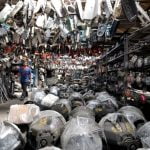Top crop: Once they get going, beans will provide an almost-daily bounty.
OF ALL THE summer vegetables, beans are among the easiest to grow because they love a warm-soil start.
Production, even in a small area, can be virtually non-stop for up to five months if seeds are sown over the next week.
The real space-savers are climbing beans because they occupy only a small amount of ground.
The plants can be trained to grow against sunny walls, fences or easily made climbing frames.
First, prepare the growing area by digging deeply and mixing in lots of fully decayed mushroom compost and well-rotted manure.
Water deeply to settle the soil, then leave overnight so even the subsoil becomes moist.
A bundle of 2m-long garden stakes tied together can make excellent supports for all climbing bean plants.
Climbing frames can be erected anywhere in a sunny position at low cost and quickly dismantled and stored away at the end of the season.
Don’t waste money buying punnets of straggly climbing bean seedlings because they detest disturbance and either die or remain stunted.
Directly sowing climbing bean seeds is quicker, cheaper and ensures strong, vigorous, highly-productive plants. It’s a simple job, quickly carried out.
Push three seeds, half the length of your thumb into the soil around each supporting stake.
Alternatively, space them at 100mm intervals along the base of a sunny fence or wall. This is close sowing, but allows for seedling loss due to snails, birds or seed failure.
Bean seeds need just one watering at sowing time because being big seeds they can absorb and store enough moisture to carry them through to full germination.
Over-watering after sowing is the main cause of bean seeds failing to germinate.
When the newly-emerged seedlings have uncurled and formed the first two leaves, they are ready to be watered again.
At this stage, all weak or deformed seedlings can be pinched off at ground level.
As the plants grow, lightly secure the vines to climbing frames or fence supports, pinching out all growing tips as they reach the top.
This stimulates extra flowers, with the first tiny pods appearing when blooms start to wither.
The best flavoured of all climbing beans are the various types of Scarlet Runner, but the plants need cool nights at flowering time, otherwise they fail to set pods.
The pods are usually thick and coarse-looking, but don’t be fooled by the seemingly tough appearance.
They are crisp, brittle, full of juice and when sliced and steamed are tender and utterly delicious.
In warm districts, Scarlet Runner plants produce only masses of brilliant scarlet flowers, so are mainly ornamental.
Other tasty varieties of climbing bean suitable for both cool and warm districts include the heavy-cropping Blue Lake and Purple King.
It is always the immature bean pods that are edible, so they must never be allowed to fully mature. When this occurs, the pods not only become tough and tasteless, but the plants stop producing.
These are the main reasons why young bean pods must be constantly picked, always before the seeds within swell.
Even when you can no longer keep up with a constant — almost daily — production of fresh young pods, it is still important to keep on harvesting them.
Remember, all surplus bean pods freeze to perfection.
It’s a simple matter to slice them diagonally so they can be briefly plunged into boiling water. They are then dipped into ice-water to rapidly cool for packing into plastic bags and quick freezing.
When pods are harvested during the cool of the day they may be processed and frozen without blanching, provided it is done immediately.
Summer beans are always delicious and make fantastic, highly nutritious eating during winter.
[“Source-weeklytimesnow”]












